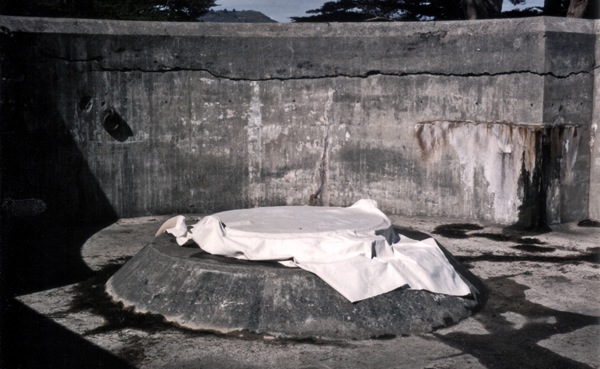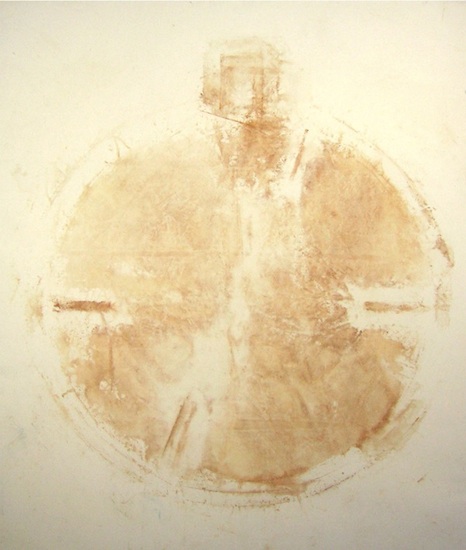 banner image: Hrayr Eulmessekian, Documentaton-Face Lift Battery East, Presidio 2001-2
banner image: Hrayr Eulmessekian, Documentaton-Face Lift Battery East, Presidio 2001-2
What comes after the bourgeois entitlement to closure?
Would it be more proper to ask, what becomes of the bourgeoisie when it finally gains that sense of closure? We are left muted to negotiate safe passage at checkpoints. In time and distance, our narratives acquire mythical proportions. Meanwhile, residues of panics and anxieties, fear and terror, compress into the thickness of opaque molasses imbalancing the delicate brain chemicals. We are left afloat with a mask to face neighbors, weddings, long weekends, bills, families, as birthdays and anniversaries accumulate.
We left Beirut amidst yet another round of heavy bombing, the reason for which were probably known only to its perpetrators. We gave up on our curiosity to understand the reasons many thousands of lives ago. We had realities reconstructed for us, in fifteen minute increments, through battery operated faith based, transistor news and newsflashes. Trying to stay safe for another day-minute-hour-second. Days and weeks would be too greedy.
The ’us’ in the second paragraph is Maral and I. Maral was studying Fine Arts at the Beirut University College. I, at the Academie Libanaise Des Beaux Arts. As if they would save us, we were frantically learning western aesthetics, color theory, and composition.
That was February of 1984 and our taxi drove us to Damascus via Lebanon’s residues; the devastated scenes of the Tripoli refugee camps (Beirut International Airport was closed again) so that we could catch a plane to the United States of San Francisco. To restart. Or so we thought.
We fled the destruction of the analog age to be naturalized in the heart of digital reconstruction. Into vocabularies and grammars that needed to be deciphered and learned before allowing oneself to negotiate an entry level position into the first world life and art, preoccupied with its own narratives, justices, injustices, socio-economies, and causes celebres. The Wall had not come down yet, and on these shores, wars were in a distant past, and they happened in distant lands.
From a distance we had learned the wholesale, but this was retail. Real and brutal.
Here, in the land of opportunity, confusing resilience with denial, our fellow migrants and refugees were busy chasing the right to join the middle to upper classes.
The following week we went sightseeing across the Golden Gate Bridge. The views of the bay were breathtaking, but what caught our attention lay in the thick overgrowth of shrubbery and weeds. Low laying military bunkers, and retired gun battery installations dotted the landscape and were still trained on the Pacific

Hrayr Eulmessekian, Coups De Grâce, saboté, 2001. bullet whole & silkscreen, 18×24 inches
A dozen years later, between the burst of the .com bubble and September 11 2001, driving down that same freeway, I finally ventured into a shooting range that I had driven by almost daily. I thought I would just go in to settle a long-standing score with those flat on flat “Targets” of Jasper Jones. A purely formalist piece that would turn the concept of target practice on its head, by having the target hit the bullet hole.
The proprietor had a Lebanese flag hanging on his office wall full of autographs. He happened to be stationed with the Marines in Beirut and was there in 1983 when the Marine barracks were blown apart. At that time, the sound waves traveled to Jeitawi, during our morning coffee as an unimpressive thud. He too had realized that wars were stupid and allowed me to go behind the scenes, into the Beirut-like bullet ridden walls and explore the possibilities.
For a long time I had referred to Cool Breeze as my Lebanon work. A precarious contraption that somehow survives disasters without the conclusion of a happy ending. I was not planning on revisiting the subject again.
The situation might be different in Lebanon, but here in the United States as an artist, my intention was to deflect the attention from me, not only because the experience was not solely mine, but for the work to acquire a life of its own I needed distance, to sort out the fetishized and tame the sensational.
And thus the series On Deep Background. I borrowed the term from journalistic practices that refer to an understanding, agreement, condition, between an official entity and a reporter, that the divulged information cannot only not be attributed to its source, it cannot even be directly paraphrased.
But what becomes of the story when the authority, confiding only on the basis of deep background, and the reporter, are one and the same, and in a search for meaning are conspiring to cover up the official narrative?
On Background Reminiscent of the first Beirut downtown reconstruction attempt, where the efforts had focused on sandblasting the grime and soot off the walls of the buildings and the patching up of the bullet holes.
My process consisted of photoshopping the bullet holes on the pictures. A futile attempt to retouch what lays underneath.
The series On Deep Background revisits the bunkers at the Presidio, now a decommissioned army base. Each consists of five layers of sandwiched transparencies, of the identical scene, photographed a few seconds apart. The layering compresses time and depth into a single glance.

Hrayr Eulmessekian, (before & after) On Deep Background, 2001/2007. color print, 36×36 in
Face Lift, the work is the process of transferring the face layer of rust off the lids covering the holes of the long removed cannons unto canvas. An absurd attempt to collect evidence that our city of choice no longer needs defending.

Hrayr Eulmessekian, Face Lift, 2001. rust on canvas, 6×7 ft
In real time, the photographer and the subject are aware of the space extending beyond the frame of the image. But for future generations, who come to learn of a past, especially a catastrophic or traumatic one, the past and the event become constrained within the frames of the photos.
Bruitage intends to erase or remove the photographed and the limits of the frame by introducing movement and time.
There are no transitions between scenes. There are only cuts. The sounds are from home videos and online sources, played back, and re-recorded and remixed live with the room tones of our house.
In the end, the viewer remembers the screening of the film, but not the memories the images contained.

Hrayr Eulmessekian, Bruitage, 2006. HD Video
It is not cool detachment that my work pursues, nor the cathartic. It does not represent but becomes present, and strives to exist only in real time. It requires the present presence, of the viewer, not a look back, nor a transportation in time and place. The works float only on a surface plane. Depth, if any, is not beyond that surface but before it.